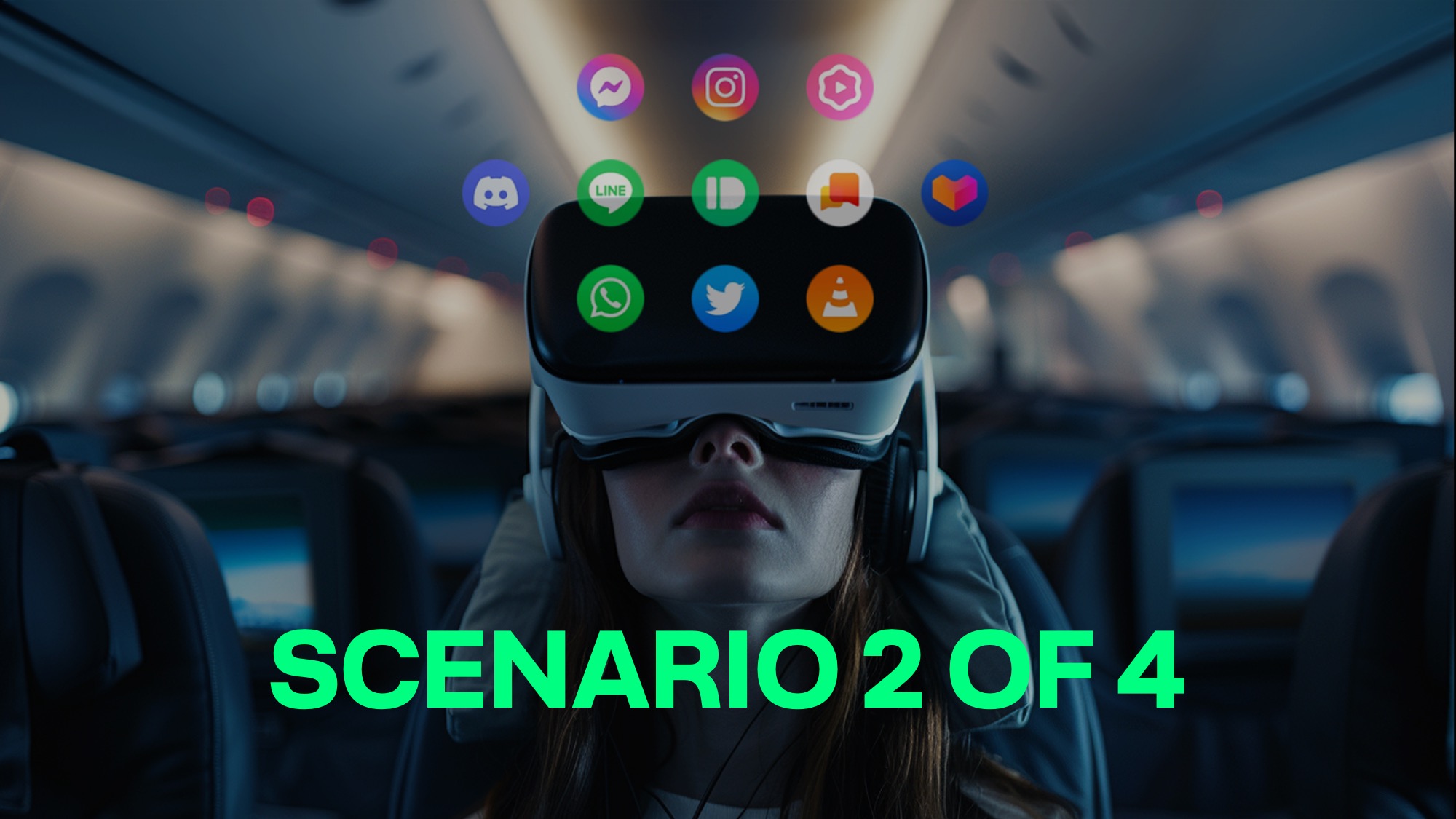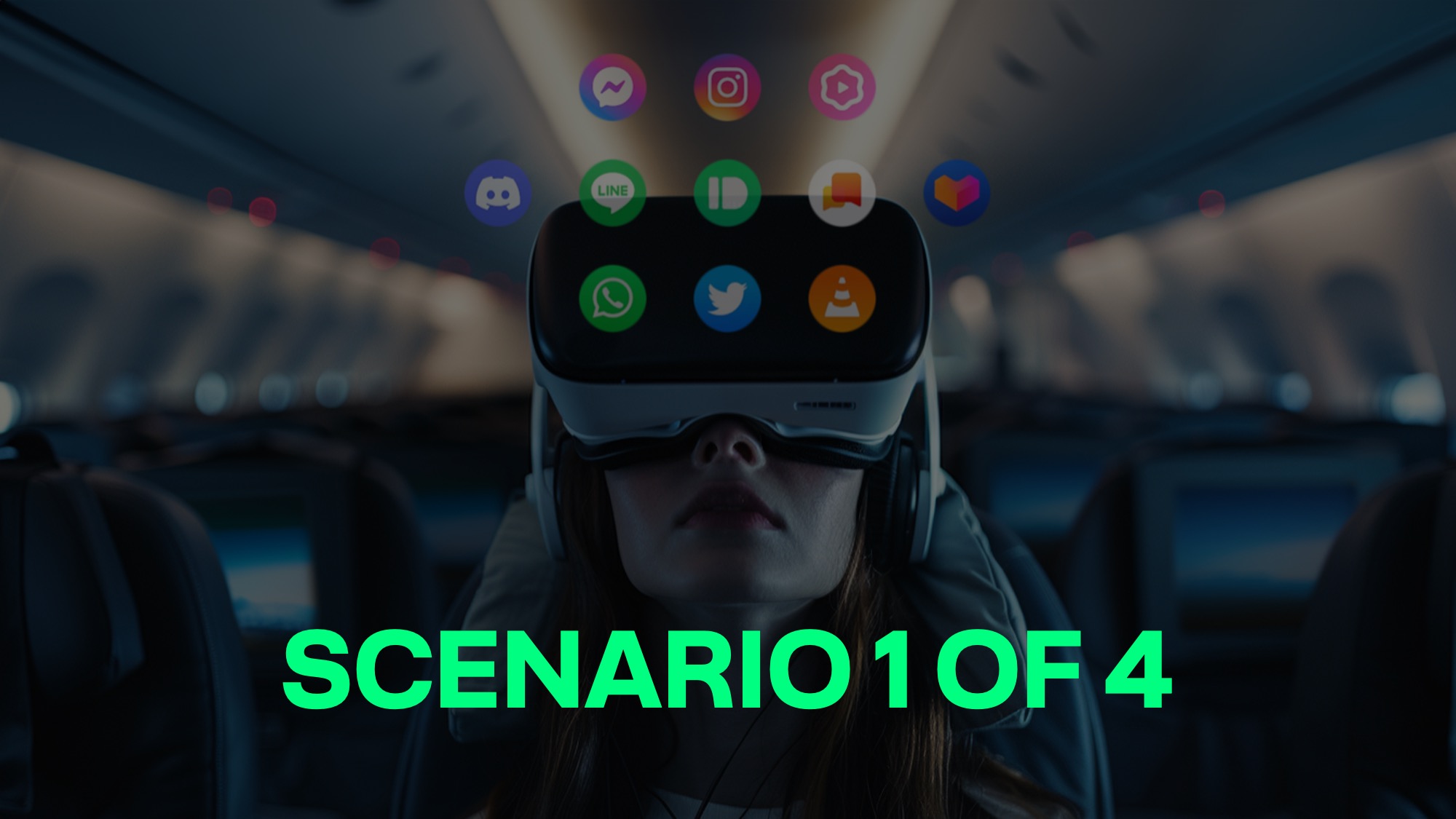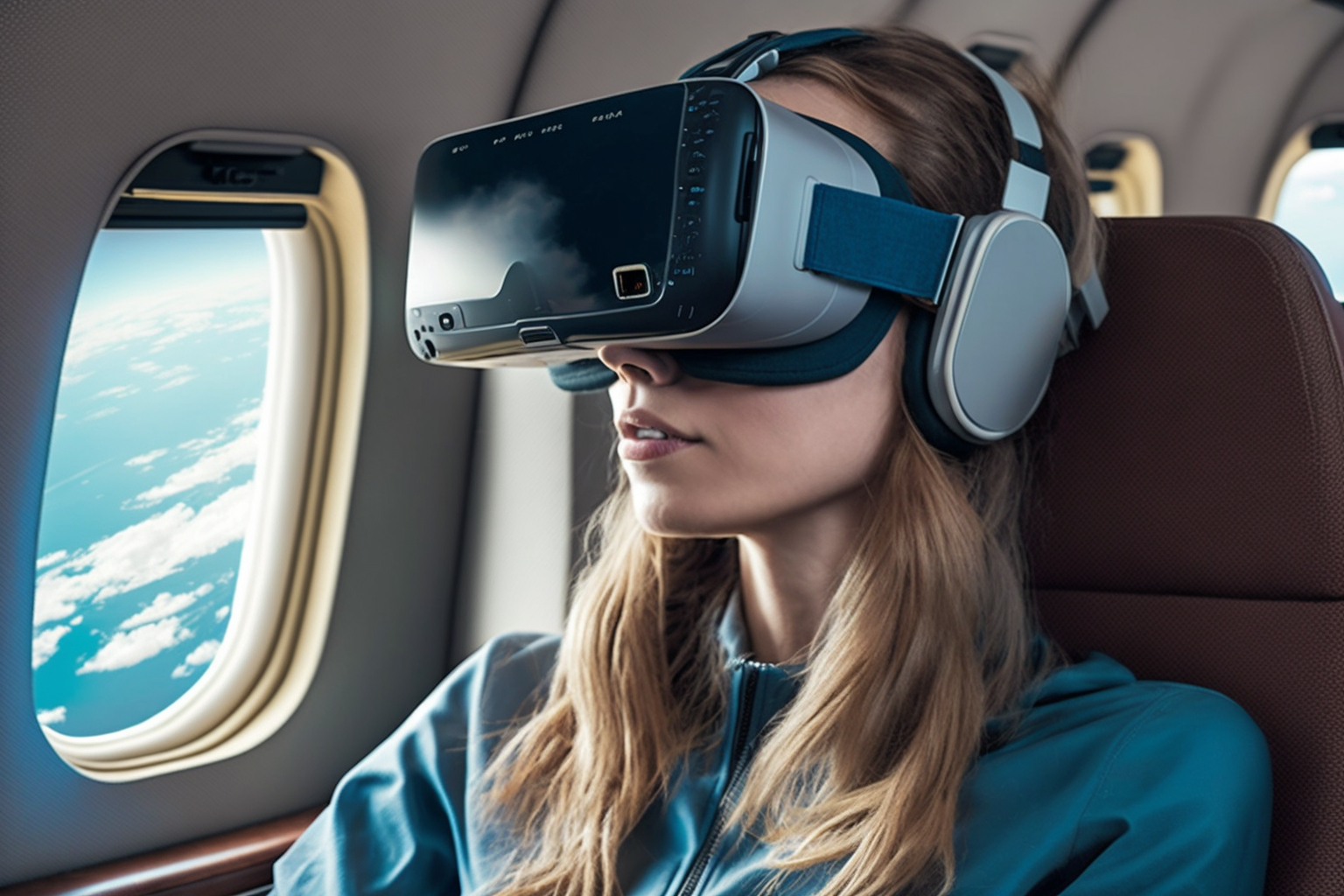The metaverse hype has experienced a rollercoaster of attention over the past five years.
While the term “metaverse” might have seen a recent decline in popularity, the core technologies fueling it—immersive tech, blockchain, and web3—continue to evolve.
This led us to ponder: How will the aviation industry navigate the metaverse landscape?
Will it position itself as an early adopter or a fast follower?
To uncover insights, we gathered a panel of industry experts from various sectors within aviation.
Joint Collaboration By Aviation Experts
We at the Lufthansa Innovation Hub, alongside industry experts from Airbus and aviation think tank Bauhaus Luftfahrt, embarked on a deep dive into the potential futures of the metaverse and its implications for aviation.
In 2023, we harnessed a scientific scenario-based approach through a series of collaborative workshops, meticulously crafting and examining four potential evolution paths of the metaverse within the aviation industry over the next decade until 2035.
In the coming weeks, we’ll unveil our key findings from these scenarios. This initial post will introduce the methodology and thought process that guided our exploration.
The Enduring Relevance of the Metaverse
In late 2021 and early 2022, the metaverse captured the tech world’s imagination, driven by rapid advancements in immersive technology, the cryptocurrency boom, and the accelerating popularity of NFTs.
However, 2023 saw a shift: the buzz around the metaverse term has waned, largely due to the absence of tangible applications and prevailing confusion about what the metaverse genuinely entails—a topic we’ve explored thoroughly in our past article series.

Does this dip in popularity signal the demise of the metaverse and its foundational technologies, such as immersive tech, NFTs, and Web3?
It’s unlikely. Although the public focus may have shifted towards other innovations like GenAI, there’s tangible progress in the adoption of Web3 wallets, the refinement of immersive technologies, and the introduction of groundbreaking hardware devices. A prime example is Apple’s Vision Pro, a pioneering mixed reality headset aimed at transforming “spatial computing” into a component of everyday life.
The potential of such immersive technology extends well beyond daily use, finding promising applications within the travel industry as well. Not only did Apple specifically configure the device for use during the travel journey, for example, for in-flight use, but airlines are also eager to experiment with its capabilities to enhance the passenger experience. For example, Beond, a premium airline, plans to provide the device to select passengers on its flights to the Maldives, offering immersive previews of the destination.
While it’s too early to fully determine the Apple Vision Pro’s impact, early adopters, including tech enthusiasts and industry insiders like Microsoft VP Omar Shahine, have shared positive inflight experiences and reviews on social platforms. This growing interest underscores the enduring potential of metaverse technologies to innovate and enrich the travel experience.

A Working Definition of the Metaverse
Given Apple’s exploration into “spatial computing”, you might wonder what their device has to do with the metaverse. Indeed, while related, they are not identical.
Let’s clarify the metaverse: it represents the convergence of our physical and virtual realities, a phenomenon fueled by two core elements:
- Immersion: Utilizing immersive technologies such as Augmented Reality (AR), Virtual Reality (VR), and Mixed Reality (MR) alongside their corresponding devices, the metaverse crafts a hybrid reality that intertwines physical and digital dimensions.
- Ownership and Exchange of Digital Assets: Very importantly, the metaverse also encompasses the capability to possess and transact digital and virtual assets within these immersive spaces, facilitating a unique economy of virtual items and experiences.
Apple’s Vision Pro distinctly ticks the box for immersion by delivering an engaging mixed reality experience. However, its current iteration doesn’t venture into digital asset management, rendering it a gateway rather than a full embodiment of the metaverse. Yet, its significance cannot be understated; it serves as a tangible step towards merging our physical and digital worlds, highlighting the potential impact on daily tasks and activities.
Envision a scenario where devices like the Vision Pro become a mass commodity, potentially even replacing smartphones. This opens the door to a new tech infrastructure supported by blockchain and digital assets. This infrastructure could host a range of applications, services, and “digital assets” tailored for immersive experiences, exemplifying the metaverse concept.
Nonetheless, the trajectory of the metaverse remains wrapped in uncertainty, including its definitive future form and application. This ambiguity led us to develop four scenarios, offering a window into possible evolutions of metaverse adoption within the aviation sector.
Our Approach: Crafting Metaverse Scenarios Based on Prioritizing Key Factors
The future of the metaverse might seem ambiguous, but the various technologies and trends likely to shape its development are not. Through a series of collaborative brainstorming sessions, we did the following:
Step 1: We identified key factors that could significantly affect how the metaverse will unfold, including regulatory and financial aspects, technological trends, and what drives adoption among consumers and businesses.
Step 2: From an initial list of well over 20 potential drivers, we evaluated and chose those deemed most critical. These selected factors are pivotal; they serve as the foundation for characterizing each of the four scenarios we’ve envisioned.

How did we decide which factors to prioritize?
We evaluated each factor based on two critical aspects:
- Potential Impact: We assessed how significantly each factor could influence the development of the metaverse. For instance, widespread consumer adoption of metaverse devices and applications is crucial. Without a broad consumer embrace of immersive technology and related apps, the vision of a comprehensive metaverse remains unachievable.
- Level of Uncertainty: We gauged the predictability of each factor’s influence on the metaverse. Consumer adoption, for example, is highly unpredictable. Elements such as cost and ease of use are pivotal. Consider the initial excitement around the Vision Pro; despite early enthusiasm and queues at Apple stores, its long-term success isn’t guaranteed. Recent feedback reports suggest a trend of returns due to discomfort, headaches, and eye strain.
In the below chart, you can see how the most critical factors score in the upper-right quadrant of our uncertainty-impact matrix. These factors are characterized by both high impact and high uncertainty, making them particularly intriguing for further exploration within our scenario analyses.

Step 3: Next, our journey of distilling the critical elements for our scenarios took a deeper dive. From the wide array of priority factors we initially identified, our task was to pinpoint the two most impactful ones—those absolutely pivotal for painting the picture of the metaverse’s potential futures.
This required another analysis, where each prioritized factor underwent a rigorous evaluation to spotlight those with the most profound implications for the metaverse’s trajectory.
Two key factors emerged as the cornerstones of our scenario framework–more on that below.

They act as the “skeleton” around which the flesh of each scenario is built, defining the core attributes and diverging paths that each potential future might take. It’s through this focused lens that we began crafting our scenarios, each one a distinct narrative shaped by how these essential factors interplay and influence the metaverse’s unfolding story.
Step 4: Ultimately, we positioned these two pivotal factors as the axes for our scenario matrix, crafting the very structure upon which our future visions of the metaverse would be built. The axes represented by these “hinges” are:
- Consumer Adoption: As previously explained, its pivotal role is unmatched, occupying the top ranks for both “impact” and “uncertainty.” It serves as a central component in the potential future of the metaverse, characterized by both possibilities and challenges.
- Metaverse Consolidation: This factor addresses the critical question of whether a cohesive, holistic metaverse infrastructure will materialize, as opposed to a fragmented landscape of platforms with limited interoperability.
Our rationale for zeroing in on metaverse consolidation is simple yet profound. Considering our view of the metaverse as a seamless blend of physical and digital worlds, enabled by immersive technology and the exchange of digital assets, its success relies on the development of a unified infrastructure. Such an infrastructure would need to transcend geographical, demographic, and product boundaries, embodying a level of consolidation or “unity” that is currently absent.
In the present landscape, we observe a patchwork of fragmented “metaverses,” from gaming realms like Decentraland to luxury retail experiences by brands such as Louis Vuitton and Gucci. However, these platforms operate in isolation, lacking the crucial interoperability that would enable a free flow of information and digital assets between them. This fragmentation poses a significant barrier to the emergence of a holistic metaverse.
Thus, by selecting consumer adoption and metaverse consolidation as our foundational factors, we laid the groundwork for our scenarios.
Each scenario explores different trajectories these factors could take, painting a comprehensive picture of the potential futures awaiting the metaverse in the travel context.

Step 5: We’ve sketched out four potential futures for the metaverse in aviation, each shaped by different levels of consumer adoption and how unified the metaverse becomes.
While detailed explorations of these scenarios will unfold in our upcoming series, here’s a sneak peek of what we’re thinking:
Scenario 1: “The Golden Islands” – Envisioning a future where both consumer adoption and metaverse consolidation remain minimal. In this scenario, metaverse experiences become a hallmark of luxury, accessible primarily to the affluent due to the high costs of immersive technology and the creation of virtual spaces. For aviation, this world sees immersive tech and platforms as a unique selling proposition tailored for the high net-worth traveler.
Scenario 2: “The Industrial B2B(2C) Aviationverse” – This scenario contrasts sharply with the first, as it imagines a landscape where, despite low B2C consumer adoption, the B2B sphere flourishes. An alliance among aviation OEMs, suppliers, and airlines gives birth to an open, shared metaverse platform dedicated to industrial applications. This unified metaverse accelerates efficiency in aircraft design, production, and testing, though consumer engagement with metaverse technologies remains rare.
Scenario 3: “The Mainstream Multiverse” – Here, consumer engagement with immersive devices and applications skyrockets, yet the metaverse remains as fragmented as today’s social media landscape. Various metaverse platforms cater to distinct use cases, social groups, or regions, supporting a broad spectrum of travel-related applications from inspiration to post-booking services, marking an era of mass adoption.
Scenario 4: “The Bet is Won” – The pinnacle of metaverse evolution, this scenario envisages an open, unified metaverse ecosystem embraced by the masses. Immersive interfaces and applications become integral to daily life, offering tangible benefits that extend into the travel domain. Aviation companies leap at the opportunity to innovate within the metaverse, enhancing customer experiences and setting themselves apart from the competition.
Each scenario paints a vivid picture of potential futures, inviting us to ponder the role of immersive technologies in shaping the next decade of aviation.
Stay Tuned For More
Ready to dive deeper into each scenario?
Over the coming months, we’ll roll out a detailed series, breaking down each scenario to uncover the potential future of the metaverse in travel.
Don’t miss out–the metaverse future might be closer than you think!









